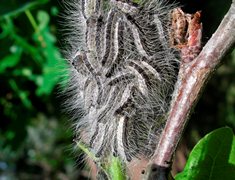Don't Touch The Caterpillars
It's that time of year again...
Every year, around this time, comes the warning - don't touch the caterpillars... or you'll know about it.
June is when the oak processionary caterpillars build their distinctive white, silken, webbing nests on the trunks and branches of oak trees.
The nests have an irritating substance called thaumetopoein, which can cause painful skin rashes and, sometimes, eye and throat irritations in people and animals.
They are also a tree pest because they eat oak leaves, and large populations can strip trees of their leaves, leaving them weakened and vulnerable to other threats.
Councillor Bassam Mahfouz, Ealing Council’s cabinet member for transport and environment, said:
''Residents are encouraged to report sightings of nests or caterpillars in their garden or in a public area. We also urge residents not to attempt to remove the pests themselves as it requires a specially trained and equipped team to do it at the right time and to dispose of them correctly.''
Dr Yvonne Doyle, London regional director of Public Health England, endorsed the ‘don’t touch’ message. She said: ''The nests can be full of irritating hairs, even after the moths have emerged, and the irritating substance in the hairs can remain active for a long time. The hairs can be blown about by the wind, so it’s important that people and animals do not touch or go near the nests.
''Anyone who experiences an itchy or painful skin rash or a sore throat and irritated eyes after being near oak trees in these areas should consult their GP or NHS 111, who have been given advice about recognising the symptoms and appropriate treatment.''
The nests are typically about the size of a tennis ball. They are usually white when new, but become discoloured to match the colour of the tree’s bark, and can be found anywhere in the tree from the trunk to the main branches. However, they can fall to the ground, where they can be accessible to children and inquisitive animals such as cats and dogs
Guidance on identifying OPM is available on the Forestry Commission’s website at www.forestry.gov.uk/opm
25th June 2013
Related links
|
